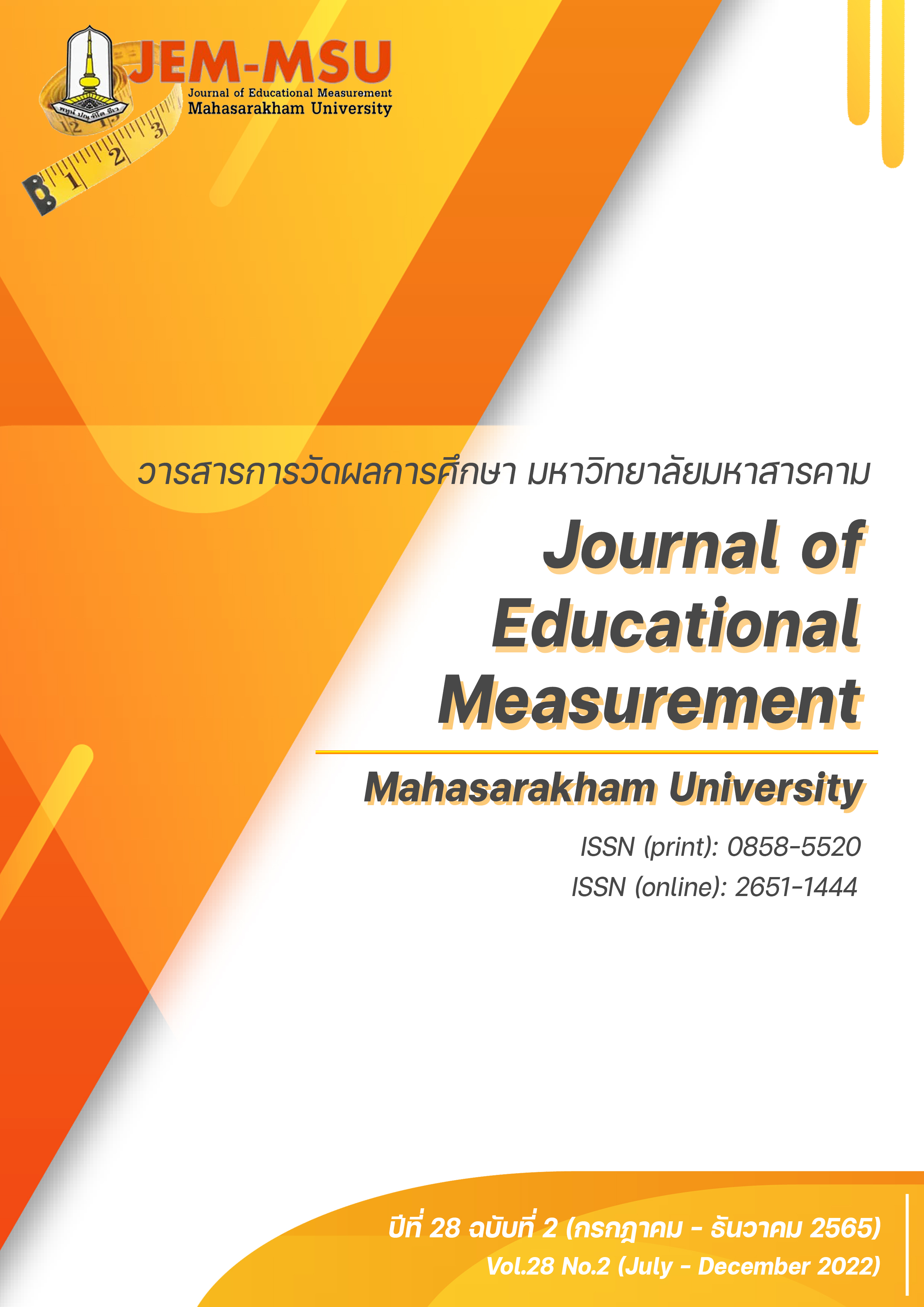Development of a Mathematical Literacy Diagnostic Test for Grade Nine Students using Attribute Hierarchy Method
Main Article Content
Abstract
The objectives of the research were: 1) to develop a mathematical literacy diagnostic test for grade 9 students by using attribute hierarchy method; and 2) to verify reliability and validity of the test developed. The research sample consisted of 283 grade 9 students, obtained by multistage sampling. The research tool was a mathematical literacy diagnostic test. The research results were as follows: 1) The test that had been developed had 8 situations; each situation contained 4 questions, totaling 32. The first question aimed to measure the ability to identify the mathematical aspects of a problem situated in the real-world context. The second question aimed to measure the ability to translate a problem into mathematical language. The third question aimed to measure the ability to employ mathematical concepts and procedures to solve problems. And the fourth question aimed to measure the ability to interpret, apply and evaluate mathematical outcomes. 2) In examining the test using Item Response Theory, it was found that the test had item discrimination parameter (ai) from 0.44 to 3.23, item difficulty parameter (bi) from -1.88 to 1.50 and guessing parameter (ci) from 0.00 to 0.31. The test had construct validity (Chi-square = 334.770, p = 0.918, GFI = 0.931, AGFI = 0.902, RMSEA = 0.000) and had Cronbach's alpha coefficient from 0.763 to 0.842. This suggests that it can identify learner’s attribute-mastery pattern and can diagnose the learner’s deficiencies in mathematical literacy.
Article Details

This work is licensed under a Creative Commons Attribution-NonCommercial-NoDerivatives 4.0 International License.
The content and information contained in the published article in the Journal of Educational Measurement Mahasarakham University represent the opinions and responsibilities of the authors directly. The editorial board of the journal is not necessarily in agreement with or responsible for any of the content.
The articles, data, content, images, etc. that have been published in the Journal of Educational Measurement Mahasarakham University are copyrighted by the journal. If any individual or organization wishes to reproduce or perform any actions involving the entirety or any part of the content, they must obtain written permission from the Journal of Educational Measurement Mahasarakham University.
References
Gierl, M. J., Alves, C. and Taylor-Majeau, R. (2010). Using the Attribute Hierarchy Method to make diagnostic inferences about examinees' skills in mathematics An operational implementation of cognitive diagnostic assessment. International Journal of Testing, 10, 318-341.
Hair, J. F., Black, W. C., Babin, B. J., & Anderson, R. E. (2010). Multivariate data analysis. Pearson Education.
Hox, J. J. (2010). Multilevel analysis: Techniques and applications. Routledge.
Leighton, J. P., Gierl, M. J., & Hunka, S. M. (2004). The attribute hierarchy method for cognitive assessment: A variation on Tatsuoka's rule-space approach. Journal of Educational Measurement, 41(3), 205-237.
Steiger, J. H. (2007). Understanding the limitations of global fit assessment in structural equation modeling. Personality and Individual Differences, 42, 893-898.
Tatsuoka, K. K., (1983). Rule space: An approach for dealing misconception based on item response theory. Journal of Educational Measurement, 20, 345-354.
Kanjanawasee, S. (2013). Classical test theory (7th ed.). Chulalongkorn University Press. (in Thai)
Kanjanawasee, S. (2020). Modern test theories (5th ed.). Chulalongkorn University Press. (in Thai)
PISA Thailand IPST. (2014). PISA 2012 Results: Science, Reading and Mathematics. The Institute for the Promotion of Teaching Science and Technology. (in Thai)
PISA Thailand IPST. (2018). PISA 2015 Results: Science, Reading and Mathematics. The Institute for the Promotion of Teaching Science and Technology. (in Thai)
Susheva, S. (1995). The Development of diagnostic method for detecting mathematical misconception [Doctoral Dissertation]. Chulalongkorn University. (in Thai)
TDRI. (2010). 21st Century Skills Rethinking How students learn. [online]. Available from: http://www.tdri.or.th, Cited in The Institute for the Promotion of Teaching Science and Technology. (2015). Mathematics education at School-Level in Thailand: The Development-Impact-Current recession. (in Thai)


